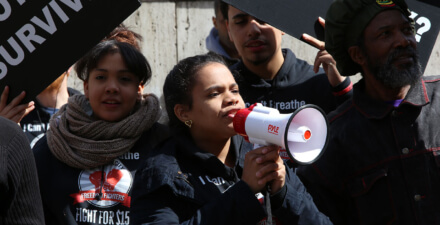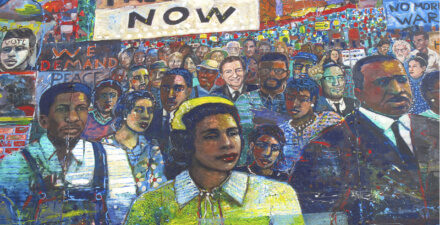How Black activists spurred the U.S. government to expand school meal programs, addressing child hunger and boosting future productivity

Every school day, millions of students at public and private, nonprofit schools across the United States enjoy free or low-cost meals supported by the National School Lunch Program and School Breakfast Program. These programs are important complements to other anti-hunger and anti-poverty programs in the United States, such as the Supplemental Nutrition Assistance Program (formerly known as food stamps). Prior to pandemic-related disruptions to education beginning in 2020, these school meal programs fed 30 million and 15 million students, respectively, each year.
While advocates continue to push for improvements to the programs, including lower costs to families and more nutritious meal options, school meal programs serve an important role in our national education system: They ensure that students can get through the day with full bellies and the fuel they need to focus on their lessons.
It’s difficult to imagine a school without these meal options today, but they are, in fact, relatively recent advancements in the long history of public education in the United States. The School Breakfast Program, for example, was not permanently authorized until 1975—more than a century after the widespread expansion of public education across the country.
The program’s enactment didn’t come easily. Black activists—including civil rights leaders, the NAACP, and the often-demonized Black Panther Party—were instrumental in pushing policymakers in their neighborhoods and the halls of Congress to address the growing problem of hunger in their communities. In the absence of government support, these activists worked to establish their own meal programs—most notably the Black Panthers’ free breakfast program—and engaged in direct advocacy that inspired, shamed, and eventually spurred policymakers into action.
These efforts have fed generations of students, helping them focus in school and setting them on a path to longer-term productivity and economic security. In this column, we examine the activism that led to the expansion of government-provided school meal programs, as well as the long-run impact on students across the United States.
Black activists fed their communities while advocating for broader, permanent reform
The Black Panthers’ free breakfast program—similar to its other survival programs, including free medical research health clinics, free ambulance services, and free clothing services—was born out of material necessity. In 1969—the year that the Black Panther Party served its first free breakfast at St. Augustine’s Church in Oakland, California—around 1 in 3 Black Americans had incomes that fell below the poverty line, or approximately triple the poverty rate of White Americans. The effects of not being able to afford to put food on the table for children was described as one member of the Party in this way:
The teacher teaches, using examples and talks about taking 14 apples and dividing them with 7 friends and ending up with 2 apples apiece. At the sound of the word apple, the Black child’s face looks up and seems to know what she’s talking about, but soon his mind returns to the 14 apples and he wishes he had something to eat … the result is that the child falls farther behind. The root cause of this problem is not mental incapabilities or cultural deprivation, but hunger.
Another member of the Party posed the question, “How can a person be expected to pay attention and learn about history, math, science, and other subjects that are abstract to his reality when his mind is concentrating on a very real and concrete problem? Where is the next meal coming from?”
Important government action in the 1960s helped to alleviate poverty across the United States. The Federal Labor Standards Act, for example, was amended in 1967 to cover a larger share of the U.S workforce, including industries where Black workers were overrepresented, such as agriculture, nursing homes, laundries, hotels, restaurants, schools, and hospitals. President Lyndon Johnson’s “War on Poverty” in the 1960s also established landmark programs, such as Medicare, Medicaid, and Head Start, and expanded Social Security—all of which were critical to improving economic conditions for Black Americans but were not without limitations (for example, the failure to include policies advocated at the time, such as a jobs guarantee).
While the War on Poverty took the important action of making the food stamps program permanent, the program was unable to fully address pervasive hunger, meaning that children across the country continued to arrive at school hungry each morning. The Black Panthers’ free breakfast program thus filled a void left by existing government programs and rapidly grew in popularity and reach. The first day the program was in operation, it served 11 children. By the end of its first week, the program was serving 135 children daily at St. Augustine’s. In 1969, the program fed more than 20,000 children nationally. At its height between 1969 and 1971, the organization was operating at least 36 free breakfast programs nationwide, with larger chapters running multiple sites.
The popularity and effectiveness of this program did not go without notice, and for a government that saw the Black Panthers as a direct threat to a status quo of White supremacy, this was a source of alarm more than inspiration. In a 1969 congressional hearing, California assemblyman Jess Unruh put it bluntly: “I do not say this in defense of the organization. I say it by way of warning …The Black Panthers have supplied more free breakfasts than the Federal Government has.”
While it may be an overstatement to draw a direct line between the Black Panthers’ free breakfast program and the permanent establishment of the federal School Breakfast Program, the Black Panthers nevertheless provided a template for addressing community needs, as well as the motivation for a swifter government response. According to Joshua Bloom of the University of Pittsburgh and Waldo E. Martin Jr. of the University of California, Berkeley, government-sponsored breakfast programs took off around the same time that the Black Panthers were expanding their own breakfast program. In 1972, the federal government was feeding 1.18 million children—a significant improvement for a program that had only received $600,000 in funding just 5 years prior but still far short of the nearly 5 million qualifying children.
The Black Panthers were not the only ones to advocate for the importance of food programs during this time. Many Black activists, for example, testified before the U.S. Senate Select Committee on Nutrition and Human Needs chaired by Sen. George McGovern (D-SD), and, in a series of hearings in the spring of 1970, some of the nation’s most prominent civil rights leaders stood before the committee to make the case for urgent government action to address childhood hunger.
At a February 1970 hearing, for example, the NAACP director of South Carolina, Rev. I. DeQuincey Newman, said that no county in South Carolina was “devoid of the problems of hunger, malnutrition and bad housing conditions in both cities and rural areas.” On May 14, Rev. Ralph David Abernathy, the president of the Southern Christian Leadership Conference, pointed out gross deficiencies in President Richard Nixon’s existing food programs. And in a July hearing, Jean Fairfax, former chair of the Committee on School Lunch Participation and an NAACP lawyer, testified that school meal programs were underserving as many as 23 million children.
The school food movement continues to this day, boosting human capital development and long-term economic growth
As a whole, pressure from these activists and others was an important part of the effort to expand the federal School Breakfast Program and make it a permanent government policy. While President Harry Truman established the National School Lunch Program in 1946, providing free or reduced-cost lunches at public and nonprofit schools, it was not until 1975 that the federal government permanently instituted the School Breakfast Program as a resource to support vulnerable children—a move prompted by the work of Sen. McGovern’s committee to expand the initial pilot program.
Since then, policymakers and advocates have continued the work spurred on by Black activists to reform and improve these school meal programs so that no child has to go to class hungry. In 1994, for example, a number of changes were made to the National School Lunch Program, primarily emphasizing the need to standardize the nutritional quality of school meals. Then, in December 2010, Congress passed the Healthy, Hunger-Free Kids Act, reauthorizing the school meal programs and focusing on improving children’s access to nutritious foods and promoting healthy eating and physical activity. This revision of standards—which required meals to contain more fruit, vegetables, and whole grains, while also limiting the amount of calories, saturated fats, and sodium in the meals—was the first overhaul of requirements in more than 15 years.
The federal government has also integrated student health and school wellness into policy and practice through the Every Student Succeeds Act, recent legislation that amended school policy in the United States. Through this act, Congress provided additional funding for lunch programs and created a universal meal option—the Community Eligibility Provision—which allows high-poverty schools to offer breakfast and lunch at no charge to all students, thus eliminating the traditional school meal application process.
These policies meet a basic human need while helping students succeed in the classroom, strengthening the human capital of tomorrow’s workforce and ensuring a more vibrant economic future for us all. Research shows that eating breakfast before school can improve memory, alertness, mood, and school attendance among students. A 2016 study of the School Breakfast Program finds that policies requiring schools to offer breakfast were associated with healthier eating and even improvements in students’ math scores.
These findings are not surprising in light of the broader literature on similar policies. The school lunch and breakfast programs act both as nutritional support and income support as they offset families’ food costs and allow them to divert limited resources to address other needs. These are the same mechanisms through which the Supplemental Nutrition Assistance Program promotes long-term economic growth and well-being. A 2020 working paper by Martha Bailey, Hilary Hoynes, and Maya Rossin-Slater demonstrates that children with early access to these supports grow up to be better-educated and live healthier, longer, and more productive lives. These school meal programs, championed by Black activists for decades, may offer similar benefits as they feed more children consistently throughout the school year.
Conclusion
Today, the National School Lunch Program and School Breakfast Program feed tens of millions students every day with low-cost or free nutritionally balanced meals. While these school meal programs have been a tremendous resource for low-income and disadvantaged children, they alone are not the silver bullet for eliminating childhood hunger in the United States.
In 2020, 14.8 percent of households with children, disproportionately Black and Latino, were food-insecure. Along with school meal programs, income supports, such as SNAP and the expanded Child Tax Credit, have been shown to meaningfully reduce childhood hunger. Supporting school meal programs while expanding access to and duration of these income supports are critical policy tools for continuing to lower U.S. child poverty rates and setting more children on the path to a healthier, more productive future.
The revolutionary anti-hunger work of the Black Panthers and other Black activists demonstrates the power that community advocacy can have on national issues. Reacting to centuries of legalized harm and government inaction that led to poverty and hunger among Black, Indigenous, and other people of color, these activists engaged in mutual aid efforts and direct political advocacy that has helped feed the children of millions of U.S. families.
Faced with inaction, these activists made the urgency of the issue impossible to ignore and showed policymakers what a community-driven response can look like. The best way for policymakers to honor their legacy and historical contribution this Black History Month and beyond is to ensure that such efforts will no longer be necessary, and that no child, of any race or socioeconomic status, has to wonder where their next meal will come from.






